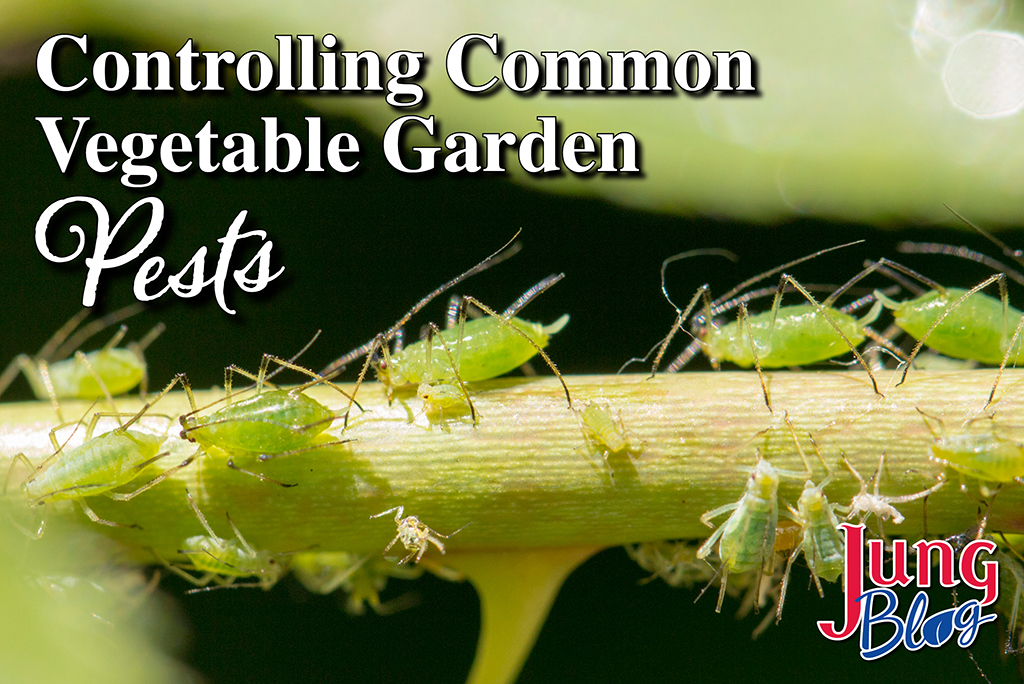
If you’ve grown veggies before, you understand the satisfaction of harvesting the fruits of your labor. But you also know the struggles of dealing with insect pests intent on consuming the harvest for you. Each type of vegetable is prone to certain insect pests, so it’s crucial to scout your crops to minimize their impact regularly. Today we’ll look at common insect pests and how to manage them in your garden. Keep in mind these are only some insect pests you may encounter, and most insect species are beneficial for your plants. To learn more about insect pests, head to your local Jung Garden Center or use online resources provided by your local extension office.
Aphids
These pear-shaped soft-bodied insects use their mouths to suck the sap from the plant’s leaves, causing the leaves to be stunted, malformed, or die. The most common aphids in the Midwest are green, but you can also find red, black, yellow, or pink aphids.
Symptoms
These include reduced plant vigor and malformed or yellowing leaves. Another common symptom is a sticky substance on the leaves, called honeydew, along with sooty mold with a black appearance. The aphids are found on stems and the underside of leaves, typically in large colonies.
Control
Aphids are controlled using several methods. For small infestations, crush them with your hands as you inspect each plant. A strong jet of water can disrupt the aphids and make them unable to feed. Insecticides can be used only if the product label says the chemical is safe for edible plants.
Leaf Miners
This insect is hard to spot, but the symptoms of its presence are easy to notice. You can find them on various plants, but their damage is most problematic on leafy greens.
Symptoms
Large areas of dead leaf tissue are the most common symptom, and they often attack young leaves. The areas of dead tissue may have an irregular shape, like squiggly lines.
Control
Natural enemies are the best defense against this pest, but keeping your garden clear of weeds prevents leaf miners from having a food source to attract them. You can apply row covers in areas where leaf miner damage has not occurred in the past. Using row covers in areas with previous issues doesn’t work because their pupae hatch at the base of plants they infected in the past. Crop rotation is always recommended for minimizing pests and diseases.
Slugs
Slugs can impact both ornamental and edible plants. They are usually found in cool and moist areas, like under the foliage of vegetable plants. Because they prefer cool temps, they are more active at night. Their slime trails tell you that slugs are active in your garden. Younger plants are more severely damaged by slugs as they chew on the leaves. However, they also enjoy eating the fruit. Slugs have a snail-like appearance but no shell.
Symptoms
Common ones have dried slime trails on leaves and irregularly shaped holes in the leaves.
Control
Look for signs of slugs on cool, cloudy days, or look for them in the evening with a flashlight. They can be hand-picked and put in soapy water. A garden that encourages other natural predators (Ground beetles, fireflies, toads, birds) will also reduce slugs.
Squash Vine Borer
These moths affect Squash and Pumpkin crops, with severe crop damage if their population is high. The black-orange moths emerge in mid-June and are active for about 4-6 weeks as they lay eggs at the base of susceptible plants. Larvae from these insects feed into the plants’ stems, causing wilting on affected stems.
Symptoms
A common symptom is plant wilting. Look for holes near the base of the plant, as various problems can cause wilting. Also, watch for the black-orange moths, which are easy to spot and make a loud buzzing sound.
Control
Floating row covers can be set up when you’ve seen the first sighting of the borer moths, usually in late June or early July. However, you shouldn’t cover the plants if they are flowering, as pollinators won’t be able to access those flowers. Use crop rotation to minimize infestations the following year, as the moths lay eggs near the previous year’s host plant. Insecticides can be used when the first adults are detected.
Tomato Hornworms
These monster-like caterpillars can wreak havoc in a short time on tomato plants. Hornworms are recognized by their sizeable green body, white V-shaped marks on their side, and a black “horn” on their back. They primarily feed on Tomatoes but may feed on Potatoes, Eggplant, and Pepper. Their body is hard to spot as it blends in with the green leaves.
Symptoms
They begin eating leaves on the upper parts of the plant and can defoliate entire plants in a couple of days.
Control
Picking the caterpillars off the plant is most effective, as their large bodies are easy to handle. Several predators consume these caterpillars, often covering the hornworm with small rice-like cocoons. If you see these cocoons on a hornworm, leave it be, as the predator insects will kill it. Insecticides can be used but aren’t usually necessary.
Two-spotted Spider Mites
These are found on many types of vegetables, fruit, and houseplants. Spider mites have sucking mouthparts that feed on the undersides of leaves, and their populations rapidly grow during hot weather.
Symptoms
As spider mites feed, the affected leaves become mottled with tiny white or yellow spots. You may also notice webbing on the stems and leaves. As the mites feed, the plants may become bleached-looking and drop leaves. Severe infestations can severely damage or kill the plant.
Control
Scout your plants for signs of webbing or discolored leaves, especially the undersides of the leaf, and during drought. Reducing plant stress goes a long way in preventing mites. A strong jet of water can minimize the insects and their webs. Very few insecticides are effective against spider mites, so only use chemical control as a last resort.

Scouting for pests will limit problems and help your garden produce a bountiful harvest. Happy growing!
Other Recommended Reading

- A Quick Guide To Pesticide
- Garden Pests: Japanese Beetles
- Horticultural Oil For Pest Control
- Rose Pests – Identification & Solutions
At Jung Seed Co, we strive to be your go-to guide for all your gardening needs. Our YouTube channel The Garden Doctor by Dick Zondag is where he provides gardening tips for all levels of gardeners. When you need reliable gardening advice, turn to the trusted experts at Jung.
If you are in the Wisconsin area, please visit us at one of our Jung Garden Center locations for all your gardening needs. Otherwise, you can browse our website. To receive info on new products, exclusive deals, and specials, sign up for our weekly email. Join our Facebook page, to discuss all things gardening!
About the Author: Matthew Olson is a professional horticulturist and garden writer. He has a bachelor’s degree in horticulture from UW-River Falls and is a certified professional with the Minnesota Nursery and Landscape Association. His enthusiasm for plants and the outdoors brought him to the green industry. He regularly writes articles about gardening for both gardeners and industry professionals. He can be reached at matt@mattolsonhorticulture.com.